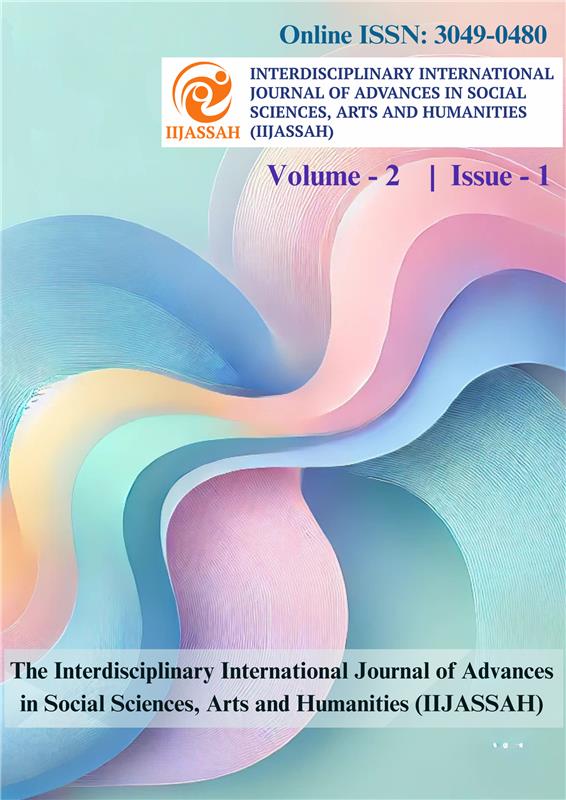Abstract
Interstate migration has become a significant demographic and socioeconomic phenomenon in India, with 37% of the national working population comprising interstate migrants. Kerala, in particular, receives approximately 0.23 million migrants annually and currently hosts around 3.4 million interstate migrants. While migration has contributed positively to the state's labour force and agricultural productivity, it also presents critical challenges to food security, particularly among migrant communities. This study investigates the complex relationship between interstate migration and food security in Kerala. Moving beyond traditional push-pull frameworks, it incorporates emerging factors such as climate change, conflict, and chronic poverty. The research utilizes a mixed-method approach, combining quantitative data on migration, remittances, and food security indicators with qualitative insights from interviews conducted under the Anusandhan National Research Foundation (ANRF) project on migrant healthcare access. Findings reveal a paradox: although migrant labour significantly contributes to Kerala's food economy, migrants remain excluded from food security frameworks despite national initiatives like the 'One Nation, One Ration Card' scheme. The study underscores the pressing need for inclusive food security policies that explicitly address the vulnerabilities of interstate migrant workers. This research advocates for integrated policy reforms that acknowledge the critical role of migrants in the state's socioeconomic fabric and ensure equitable food security for all residents, regardless of migratory status.
Introduction
Interstate migration has become a defining feature of India's labour market, with Kerala emerging as a major destination for migrant workers. These workers have become indispensable to the state's economy, engaging in a wide range of occupations—84 in total, according to findings from the Anusandhan National Research Foundation(ANRF) project on healthcare access for interstate migrants. However, despite their growing presence and contributions, interstate migrants in Kerala remain particularly vulnerable to food insecurity.
At the international level, the discourse around migration and food security is evolving. Scholars and institutions increasingly argue that migrants must be viewed as victims of displacement and active contributors to food systems (Crush & Ahmed, 2024). However, this recognition has yet to be fully integrated into domestic policy frameworks, especially at the state level in India.
Fieldwork conducted under the ANRF project in Kerala and preliminary studies from West Bengal and Assam underscore poverty as a primary driver of migration. Climate change, unemployment, low wages, and lack of secure employment also play critical roles. These observations align with the Market Condition Theory of Migration (Smith, 1994), which suggests that migration is a rational response to disparities in labour market conditions—specifically, the pursuit of higher wages and job opportunities.
However, migration as a strategy for overcoming poverty and food insecurity introduces a paradox. While remittances from migrant workers often improve families' food security in their home states, the workers frequently experience exclusion and precarity in the destination states. The International Organization for Migration (IOM, 2018) reinforces this perspective, noting that migration results from and responds to food insecurity, particularly among the poorest and most vulnerable populations.
This study examines the intersection between interstate migration and food security in Kerala. Drawing on empirical data from the ANRF project and supported by quantitative and qualitative methodologies, it explores the socio-economic dimensions of migration, the paradoxes of food insecurity among migrant workers, and the urgent need for inclusive policy interventions.
Methodology
This study employs a mixed-methods approach to explore the relationship between interstate migration and food security in Kerala, drawing on data from the Anusandhan National Research Foundation (ANRF) project. Data collection took place from September 2022 to September 2024 across all 14 districts, using KoBoToolbox for digital data gathering. Of the 1,700 responses collected, 1,554 valid samples were used after data cleaning. Quantitative data was derived from structured questionnaires, while qualitative insights were obtained through semi-structured interviews with key informants—government officials, ration officers, NGO workers, academicians, and community activists. Focus group discussions with migrant workers and field observations in settlements, particularly in plywood, construction, fisheries, hospitality, and textile sectors, provided further depth.
Quantitative data was analyzed using SPSS through descriptive statistics, cross-tabulations, and correlation analysis. Thematic analysis was employed for qualitative data, with transcripts coded into themes like ration card access, meal regularity, remittance dependence, and policy exclusion. The study acknowledges limitations, including potential sampling and response biases, language barriers, and the challenges of migration’s seasonal nature. Despite these, the triangulation of data sources and methods contributes to the reliability and comprehensiveness of the findings.
Discussion
The Role of Migrant Workers in Kerala's Food Supply Chain
A key finding of the Anusandhan National Research Foundation (ANRF) study is that interstate migration constitutes a critical component of Kerala's food supply chain. Migrant workers' engagement in agricultural activities significantly contributes to regional food security. It is estimated that between 500,000 and 700,000 migrant workers are currently employed in Kerala's agricultural sector (Parida & Raman, 2021). Beyond their roles in host states, migrants also enhance food security in their home states through remittances, highlighting the bidirectional interdependence between migration and food security. However, this relationship also reveals heightened nutrition, health, and socio-economic well-being vulnerabilities.
In India, food security remains a pressing concern among migrant communities. A substantial proportion of Scheduled Tribe members, who migrate due to chronic poverty, face food insecurity stemming from exploitative practices by informal actors. The Attappadi region in Kerala exemplifies this issue, where food distribution remains inadequate despite substantial government expenditure. According to the ANRF survey, migrants often face systemic exclusion from food access in host communities, primarily due to entrenched caste and kinship networks that limit their social mobility and entitlements.
The study further reveals that not all migration trajectories improve economic security. Migrants returning from states such as Uttar Pradesh, Bihar, Delhi, and Maharashtra reported severe income constraints and food deprivation. The situation is particularly dire in India's extreme poverty zones, where access to subsidized food through the Public Distribution System (PDS) remains limited (Balarajanet al.,2016). Established in 1944, the PDS currently serves approximately 230 million ration card holders through 534,000 outlets, with 88% equipped with Electronic Point of Sale (EPOS) machines (Department of Food and Public Distribution, 2020).
During the COVID-19 lockdowns, ration card holders were entitled to minimum food allocations from the government, including 5 kg of rice or wheat and 1 kg of pulses (Department of Food and Public Distribution, 2021). However, migrant workers—both domestic and international—were disproportionately affected. In Kerala, the sudden loss of income forced many migrants to rely on charitable organizations and government relief. Reports indicated overcrowded food distribution centres, queues stretching up to two kilometres, and incidents of stampedes and deaths due to insufficient supplies. Administrative failures, including exclusion from beneficiary lists and issues with online e-coupon registration systems, exacerbated these challenges. Despite increasing Aadhaar enrolment, many migrants remain excluded from the ration system due to bureaucratic delays or lack of awareness.
Efforts to promote ration card portability under the "One Nation, One Ration Card" scheme have demonstrated improved intra-state mobility, particularly in states with adequate infrastructure and public awareness campaigns. In Kerala, coordination with central initiatives like the PDS, Integrated Child Development Services (ICDS), and the Mid-Day Meal Scheme is commendable. However, a more inclusive, life-cycle approach is required to ensure food security. The National Food Security Act (NFSA), implemented in Kerala in 2016, aims to stabilize prices and promote food access among economically vulnerable groups. Under this framework, Antyodaya Anna Yojana (AAY) households receive up to 35 kg of subsidized food grains monthly, enhancing local market activity and supporting regional food stability.
Nonetheless, the Kerala Legislative Assembly has acknowledged that the state's shift from a production-based economy to a consumer-driven model has compromised self-sufficiency. With domestic food grain production meeting only 25% of its needs, Kerala heavily depends on neighbouring states for essential supplies. Addressing these structural deficits requires strengthening the food supply chain and investing in agro-infrastructure. While the state has achieved considerable advancements in education, health, and public awareness, ensuring the nutritional security of migrant workers remains an urgent socio-economic priority.
Kerala's universal ration system—based on colour-coded ration cards stratified by income status—represents a progressive model of equitable food distribution. Enhancing access to subsidized food grains contributes to the broader goal of economic inclusion. However, migrant populations remain largely excluded from these benefits. According to the Civil Supplies Department, a significant barrier is the lack of Aadhaar-ration card linkage among migrant workers.
Findings from the ANRF survey and focus group discussions underscore this exclusion. Of the 1,554 migrant workers surveyed, 11 migrants possessed ration cards in Kerala, and they did not regularly receive food supplies. Many migrants lacked awareness of the linkage between Aadhaar and the ration distribution system. Sathyapal, a retired supply officer, noted that low Aadhaar updating rates among migrants significantly hinder their access to the "One Nation, One Ration Card" scheme (Khadaret al.,2024). These findings point to a critical need for administrative reform, awareness initiatives, and policy inclusion to ensure food security for this vulnerable population.
| Possession of Ration Card (Kerala) | |||||
|---|---|---|---|---|---|
| Frequency | Percent | Valid Percent | Cumulative Percent | ||
| Valid | Yes | 11 | 0.7 | 0.7 | 0.7 |
| No | 1543 | 99.3 | 99.3 | 100.0 | |
| Total | 1554 | 100.0 | 100.0 | ||
Food Patterns, Health, and Food Security Challenges
Food insecurity is a pressing public health issue, defined by the U.S. Department of Agriculture (Rabbittet al.,2025) as the “limited or uncertain availability of nutritionally adequate and safe foods, or the limited or uncertain ability to acquire acceptable foods in socially acceptable ways.” This condition is closely associated with unhealthy dietary patterns, malnutrition, and increased risk of non-communicable diseases such as cardiovascular ailments and obesity (Morales & Berkowitz, 2016). Among interstate migrant workers in Kerala, the dual burden of poor diet and limited access to culturally appropriate and nutritious food has emerged as a critical concern.
The ANRF (2022–2025) study observed that 69.58% of migrant workers reported no significant health impact from dietary changes post-migration. However, 26.85% stated that dietary transitions adversely affected their health. Despite a majority not perceiving an immediate connection, data from health assessments highlight that dietary transitions can lead to gastrointestinal discomfort, loss of nutritional adequacy, and long-term health consequences. Challenges reported by workers included the unavailability of nutritious food (17.68%), loss of access to natural food (0.45%), food-related illness (0.26%), and adjustment to unfamiliar food (4.62%).
These findings echo research from diasporic contexts, such as Parackal, (2023), who documented elevated risks of diet-related diseases among South Asian migrants in the West, indicating a global pattern of health vulnerabilities linked to post-migration dietary adaptation. Gherasimet al.,(2020) also emphasize the urgency of establishing population-specific dietary guidelines to mitigate nutrition-related health disparities.
The language barrier is a critical but often overlooked factor contributing to food insecurity. In the ANRF survey, 80.42% of workers identified language difficulties as their primary challenge in Kerala, followed by cultural differences (51.04%) and legal uncertainty (24.97%). The common misperception that all migrant workers speak fluent Hindi undermines their access to services.
In reality, most workers primarily communicate in regional languages such as Bengali, Assamese, and Odia. Miscommunication in ration shops and public service offices significantly limits access to essential food resources. This linguistic exclusion underscores the need for multilingual service delivery systems and culturally responsive food security interventions.
Food practices within migrant camps reflect further structural vulnerabilities. ANRF field visits to over 1,000 camps revealed that 83.07% of workers prepared their meals, with only 37.68% having access to a separate kitchen. Alarmingly, 27.11% cooked in their bedrooms, posing significant fire hazards, while others used open or improvised kitchen areas. A notable number of workers relied on diesel for cooking due to the unavailability of gas or kerosene, further amplifying health and safety risks.
Several welfare schemes have been implemented to safeguard food security for migrant populations. The Supplemental Nutrition Assistance Program (SNAP) in the United States, the Asylum Seeker Benefit Scheme in the European Union, and Australia's Humanitarian Settlement Program—which provides food support to newly arrived migrants—are illustrative examples. In contrast, the situation in Kerala, India, reveals a significant policy vacuum. Migrant workers, despite being Indian citizens, often experience conditions akin to second-class citizenship (Khadar, 2022). The central and state governments have failed to adopt comprehensive policies to secure food access for this population. Consequently, migrant workers are frequently excluded from the Public Distribution System (PDS), vital to ensuring food security. While the Antyodaya Anna Yojana (AAY) aims to supply subsidized food grains to the most vulnerable, the absence of a clear implementation framework restricts its accessibility for migrants.
Kerala is classified as a food-deficit state due to the significant gap between its food grain production and consumption (Kannan, 2000). However, the availability of rice, the primarily distributed grain, does not automatically translate into improved food security for migrant workers. This is partly because the dietary preferences of migrants differ from the local population. Migrants are often provided with grains that do not align with their traditional food habits, alienating them from the existing food distribution system and further disconnecting them from food security.
Another structural challenge arises from the ambiguity regarding the responsibility for ensuring food security for migrant workers. Kerala maintains that its food provisions are designated for its resident population of approximately 30 million, excluding the 3.4 million migrant workers. According to this logic, the central government's food allocations are intended solely for permanent residents, leaving the onus on the migrants' home states to provide for their food security—a notion lacking administrative feasibility and federal coherence. This raises a critical policy question: Should the central government not ensure proportionate ration allocations to states based on their current migrant populations? The absence of updated data on interstate migration—particularly due to the outdated 2011 Census and the exclusion of migrant data in most administrative systems—exacerbates the problem and undermines food security interventions.
Despite these challenges, Kerala's efforts to bolster food availability during crises, such as the COVID-19 pandemic, highlight the resilience of its food security infrastructure. According to information obtained through the Right to Information (RTI) Act by the ANRF, during the pandemic, the state—through collaboration with the Construction Workers Welfare Board—distributed food kits worth ₹4 crore to migrant workers. However, reports of abandoned food items at railway stations suggest a mismatch between distribution practices and the actual needs of migrant recipients. This underscores a deeper policy failure: Food security for migrants must account for cultural and nutritional relevance, not merely availability.
Policy Recommendations
The persistent exclusion of inter-state migrant workers from mainstream food security frameworks necessitates thoroughly re-evaluating existing legislative and policy mechanisms in India. The absence of food security provisions in the Inter-State Migrant Workmen (Regulation of Employment and Conditions of Service) Act, 1979, and its successor, the Occupational Safety, Health and Working Conditions Code (OSHWC) of 2020, underscores a significant lacuna in safeguarding the rights of migrant workers. Given this population's structural vulnerabilities and mobility-induced exclusions, the Government of India must prioritize a policy overhaul grounded in inclusivity, federal cooperation, and rights-based entitlements. Drawing on empirical findings and multi-stakeholder consultations conducted by the ANRF project team, the following policy recommendations are proposed:
1. Reform and Expansion of ONORC Mechanism
While the One Nation One Ration Card (ONORC) scheme offers biometric portability of ration entitlements, its implementation remains fragmented. Policy mechanisms must ensure that inter-state migrants are integrated into their host states' Public Distribution System (PDS), irrespective of domicile status. ONORC must be restructured to reflect the lived realities of internal migrants by removing procedural and technological barriers.
2. Formulation of a National Migrant Food and Health Policy
The Central and State governments should jointly develop a federal policy framework on the food and health security of migrant workers. Migratory data, disaggregated by source and destination states, must be systematically collected every five years using the Census framework. This data should inform the allocation of food resources and social entitlements through a centralized registry system accessible to all states, reinforcing the vision of "One Nation, Food for All."
3. Digital Literacy and System Integration for Migrant Populations
It is imperative to enhance digital literacy among migrant workers in their home and host states. Targeted awareness programs should focus on using Electronic Point of Sale (ePOS) machines and the Aadhaar-PDS linkage to improve access to food entitlements. Government and civil society partnerships should lead community-level sensitization drives to reduce digital exclusion.
4. Culturally Inclusive and Nutritionally Adequate PDS Programs
State governments must adapt the PDS to address the diverse dietary preferences and nutritional needs of migrant workers. This includes introducing culturally appropriate food baskets and ensuring the inclusion of vulnerable sub-groups such as pregnant women, children, and the elderly. State-specific welfare schemes should be aligned with these inclusive principles to reduce intra-state disparities in food access.
5. Promoting Social Cohesion and Inclusive Urban Policies
Migrant food insecurity cannot be decoupled from the broader context of social exclusion. Destination states should prioritize policies that promote tolerance, linguistic inclusion, and intercultural integration to foster a sense of safety and belonging. Guaranteeing access to food, healthcare, and shelter is foundational to ensuring job stability, social protection, and the overall well-being of migrant communities.
6. Leveraging Agricultural Potential for Migrant Food Self-Sufficiency
Considering the significant participation of migrant workers in the agricultural sector, state governments—particularly in Kerala—should harness underutilized arable land for food production. State-sponsored skill assessment and employment generation initiatives should align with this objective, enabling migrant workers to contribute to and benefit from local food systems.
7. Strengthening Data Infrastructure and Long-Term Migration Policy
A comprehensive national research agenda is needed to examine the intersection of migration and food security. Robust data collection systems should inform the design of targeted interventions. Furthermore, structural drivers of migration—particularly poverty—must be addressed through long-term development strategies, including investments in regional economies to reduce the compulsion to migrate for basic sustenance.
Addressing food insecurity among inter-state migrant workers requires a multidimensional and intersectoral policy response that transcends token welfare provisions and is rooted in structural reform, equity, and participatory governance.
Conclusion
Kerala's longstanding rationing system, significantly expanded since the 1960s, has played a pivotal role in ensuring food security for its resident population, particularly during national scarcity. The state's robust implementation of schemes such as the National Food Security Act (NFSA), the Public Distribution System (PDS), the Antyodaya Anna Yojana (AAY), and the Pradhan Mantri Garib Kalyan Anna Yojana (PMGKAY) reflects a comprehensive institutional commitment to hunger mitigation and malnutrition reduction among vulnerable sections. However, the existing framework reveals critical gaps when extended to inter-state migrant workers.
Despite the technological advancements and nationwide coverage envisioned through initiatives like the One Nation One Ration Card (ONORC) scheme, migrant workers in Kerala remain excluded mainly from accessing subsidized food grains. This exclusion persists even though they are technically covered under the NFSA, raising questions regarding the inclusiveness and efficacy of food security policies for mobile populations. Data obtained via the Right to Information (RTI) Act indicates that over 516,000 interstate migrant workers are officially registered in Kerala (Khadar, 2025), yet a significant proportion continues to face food insecurity.
The findings from the ANRF study further underscore the multifaceted vulnerabilities confronting migrant workers—ranging from low wages, precarious employment, and language and cultural barriers to systemic exclusion from welfare schemes. The inadequate implementation of employer responsibilities and the limited reach of government schemes among unregistered migrant populations compound these challenges. Field observations in local markets reveal a troubling reliance on low-cost, poor-quality food, highlighting a severe nutritional deficit and the socio-economic precarity of this workforce.
In sum, while Kerala's food security framework is often lauded as a model of welfare governance, its exclusionary impact on inter-state migrant workers necessitates urgent policy reforms. There is a critical need for an integrated food security strategy that includes context-specific provisions for migrant workers—one sensitive to their mobility, dietary needs, working conditions, and socio-cultural location. Without such targeted interventions, the broader goals of food justice and inclusive development remain unfulfilled.
Author Contributions
The first author has conducted extensive fieldwork across Kerala over the last nine years. He works as a project associate for the ANRF project. He also visited West Bengal and Assam to understand the reason for interstate migration to Kerala. In this article, his field insights are incorporated.
The second author has fifteen years of research experience in international and internal migration and is currently the ANRF project's principal investigator.
The third author is also a co-investigator of the ANRF project. The second and third authors analyse the data, providing interpretation. The co-authors cover the methodology part.
Funding
The study was conducted under the funding and support of the government of India Anusandhan National Research Project entitled "Effect of Social, Institutional, and Technological Interventions on Access to Healthcare Among Interstate Migrant Labourers in Kerala". The reference number of the project is CRG/2021/004314.
Conflict of Interest
The authors declare that there is no conflict of interest regarding the research, authorship, or publication of this study. The research was conducted independently, without any influence from sponsors, funding agencies, or external organizations that could affect the objectivity of the findings.
Acknowledgment
The study acknowledges the persons and organisations that support data collection. The Centre for Migration Policy and Inclusive Governance, Mahatma Gandhi University, provides extensive literature for this study. Dr Sujata Ramachandran, Department of Political Science, Wilfrid Laurier University and Balsillie School of International Affairs, Waterloo, Ontario, Canada, Dr Benoy Peter, Director Centre for Migration and Inclusive Development (CMID), Dr S. Irudaya Rajan, Chair, International Institute if Migration and Development (IIMAD), Dr Swathi Bhattachaterjee, Senior sub editor Anand Bazar Patrika, Dr P.B Salim IAS, Secretary West Bengal Migrant Welfare Board, Sri. Samirul Islam, Member of Rajyasbha and Chairperson West Bengal Migrant Welfare Board, Sri Hariram S.S, Sri Sambhunarayan, Fieldworkers, ANRF project, Sri Hithesh Research Intern, ANRF Project supports this study.
References
- Anusandhan National Research Foundation. (2022–2025). Effect of social, institutional, and technological interventions on access to healthcare among interstate migrant labourers in Kerala (Project No. CRG/2021/004314). Mahatma Gandhi University, Kottayam, Kerala.
- Balarajan, Y., & Reich, M. R. (2016). Political economy of child nutrition policy: A qualitative study of India’s Integrated Child Development Services (ICDS) scheme. Food Policy, 62, 88–98. https://doi.org/10.1016/j.foodpol.2016.05.001
- Crush, J., & Ahmed, Z. (2024). Cities of contagion: Pandemic precarity, migration, and food security in urban Africa. African Human Mobility Review, 10(3), 5–13.
- Department of Food and Public Distribution, Ministry of Consumer Affairs, Food and Public Distribution, Government of India. (2021). Official website of the Department of Food and Public Distribution. Retrieved from https://dfpd.gov.in/
- Department of Food and Public Distribution. (2020). Annual report 2019–20. Ministry of Consumer Affairs, Food & Public Distribution, Government of India. https://dfpd.gov.in/
- Gherasim, A., Arhire, L. I., Niță, O., Popa, A. D., Graur, M., & Mihalache, L. (2020). The relationship between lifestyle components and dietary patterns. Proceedings of the Nutrition Society, 79(3), 311–323. https://doi.org/10.1017/S0029665120006898
- International Organization for Migration (IOM). (2018). World migration report 2018. IOM. https://www.iom.int/wmr/world-migration-report-2018
- Kannan, K. P. (2000). Food security in a regional perspective: A view from food deficit Kerala (Working Paper Series No. 304). Centre for Development Studies, Thiruvananthapuram.
- Khadar, N. M. (2022). Interstate migrant workers and COVID-19 situations in Kerala: A human rights perspective. In L. Pulikkalakath & S. A. Ko (Eds.), Migrants and displaced amid COVID-19: Issues, challenges and policy options. New Delhi: Adroit Publications.
- Khadar, N. M. (2025). Inclusiveness as an organizing principle: Ensuring rights and social protection for interstate migrants in Kerala. International Journal for Multidisciplinary Research, 7(1). https://doi.org/10.36948/ijfmr.2025.v07i01.37674
- Khadar, N. M., Ushus Mol, E. U., & Amilsha, A. A. (2024). Protection strategies for interstate migrant workers in Kerala: An urgent call for policy reforms. International Journal of Social Science and Human Research, 7(1), 8540–8547. https://doi.org/10.47191/ijsshr/v7-i11-46
- Morales, M. E., & Berkowitz, S. A. (2016). The relationship between food insecurity, dietary patterns, and obesity. Current Nutrition Reports, 5(1), 54–60. https://doi.org/10.1007/s13668-016-0153-y
- Parackal, S. (2023). Post-migration food habits of New Zealand South Asian migrants: Implications for health promotion practice. Journal of Migration and Health, 7, 100182. https://doi.org/10.1016/j.jmh.2023.100182
- Parida, J. K., & Raman, K. R. (2021). In-migration, informal employment, and urbanization in Kerala. State Planning Board (Evaluation Division), Government of Kerala. https://spb.kerala.gov.in/sites/default/files/inline-files/In-migrationEmploymnt.pdf
- Rabbitt, M. P., Hales, L. J., & Reed-Jones, M. (2025). Food security in the U.S. - Definitions of food security. Economic Research Service, U.S. Department of Agriculture. https://www.ers.usda.gov/topics/food-nutrition-assistance/food-security-in-the-us/definitions-of-food-security
- Smith, A. (1994). The wealth of nations: An inquiry into the nature and causes (E. Cannan, Ed.). Modern Library Inc.













